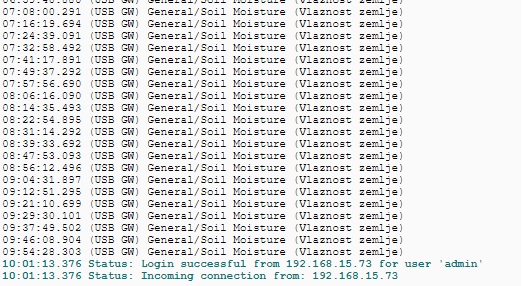Soil Moisture Sensor / analog value
-
That's from sensor:
16 MCO:BGN:INIT REPEATER,CP=RNNRA---,REL=255,VER=2.3.1 26 MCO:BGN:BFR 28 TSM:INIT 29 TSF:WUR:MS=10000 35 !TSM:INIT:TSP FAIL 37 TSM:FAIL:CNT=1 39 TSM:FAIL:DIS 40 TSF:TDI:TSL 10030 MCO:BGN:STP Hello world Loaded: 35 Warming up the sensors (15 seconds). 10042 TSM:FAIL:RE-INIT 10044 TSM:INIT 10050 !TSM:INIT:TSP FAIL 10052 TSM:FAIL:CNT=2 10054 TSM:FAIL:DIS 10056 TSF:TDI:TSL 20059 TSM:FAIL:RE-INIT 20061 TSM:INIT 20067 !TSM:INIT:TSP FAIL 20069 TSM:FAIL:CNT=3 20071 TSM:FAIL:DIS 20073 TSF:TDI:TSL -
This is from Gateway:
0;255;3;0;9;0 MCO:BGN:INIT GW,CP=RNNGA---,REL=255,VER=2.3.1 0;255;3;0;9;5 TSM:INIT 0;255;3;0;9;7 TSF:WUR:MS=0 0;255;3;0;9;14 TSM:INIT:TSP OK 0;255;3;0;9;17 TSM:INIT:GW MODE 0;255;3;0;9;20 TSM:READY:ID=0,PAR=0,DIS=0 0;255;3;0;9;24 MCO:REG:NOT NEEDED 0;255;3;0;14;Gateway startup complete. 0;255;0;0;18;2.3.1 0;255;3;0;9;28 MCO:BGN:STP 0;255;3;0;9;34 MCO:BGN:INIT OK,TSP=1 0;255;3;0;9;37 TSM:READY:NWD REQ 0;255;3;0;9;76 TSF:MSG:SEND,0-0-255-255,s=255,c=3,t=20,pt=0,l=0,sg=0,ft=0,st=OK: -
@k5austria !TSM:INIT:TSP FAIL means that the node is unable to initialize the radio. Without radio initialization, the node cannot communicate.
Triple-check the radio wiring. Replace the radio module if possible. If you don't find a problem, post pictures of the wiring here and we'll help you.
If you haven't already, check out https://forum.mysensors.org/topic/666/debug-faq-and-how-ask-for-help/ for info on how to troubleshoot efficiently.
-
@k5austria !TSM:INIT:TSP FAIL means that the node is unable to initialize the radio. Without radio initialization, the node cannot communicate.
Triple-check the radio wiring. Replace the radio module if possible. If you don't find a problem, post pictures of the wiring here and we'll help you.
If you haven't already, check out https://forum.mysensors.org/topic/666/debug-faq-and-how-ask-for-help/ for info on how to troubleshoot efficiently.
Thank you for your answer !!!
You're right. Radio module was defective (every 3 pcs.). I got new ones today and now everything works fine. I still have some questions about code.-
Why do i get response from sensor every 8 minutes ?
-
May I operate my cheap Aliexpress radio module (nRF24L01+PA+LNA) with MY_RF24_PA_LEVEL RF24_PA_MAX ? Power supply is enough.
-
-
Thank you for your answer !!!
You're right. Radio module was defective (every 3 pcs.). I got new ones today and now everything works fine. I still have some questions about code.-
Why do i get response from sensor every 8 minutes ?
-
May I operate my cheap Aliexpress radio module (nRF24L01+PA+LNA) with MY_RF24_PA_LEVEL RF24_PA_MAX ? Power supply is enough.
-
-
Thank you for your answer !!!
You're right. Radio module was defective (every 3 pcs.). I got new ones today and now everything works fine. I still have some questions about code.-
Why do i get response from sensor every 8 minutes ?
-
May I operate my cheap Aliexpress radio module (nRF24L01+PA+LNA) with MY_RF24_PA_LEVEL RF24_PA_MAX ? Power supply is enough.
-
-
What have you set as:
#define SLEEPTIME 100 // In seconds, how often should a measurement be made and sent to the server? The maximum delay between measurements is once every 254 seconds, but if you change "byte" to "int" further down in the code you could create more time between each loop. #define LOOPDURATION 5000 // The main loop runs every x milliseconds. This main loop starts the modem, and from then on periodically requests the password.5000 * 1000 = 5.000.000 milliseconds between measurements = 8.33 minutes
Change the loopduration (how long a tick of the internal clock takes) to 1000, and then the SLEEPTIME variable is in normal seconds again.
-
@k5austria said in Soil Moisture Sensor / analog value:
May I operate my cheap Aliexpress radio module (nRF24L01+PA+LNA) with MY_RF24_PA_LEVEL RF24_PA_MAX ? Power supply is enough
In my experience this will fail.

